Toyota Camry with the index XV40 was produced from January 2006 to July 2011. Almost immediately after its premiere, the car was officially sold in Europe. Since 2008, the assembly of sedans has been established. And in the summer of 2009, Camry XV40 underwent a restyling, which resulted in updated grille and front bumper, appeared turn signals in the bodies of side mirrors. Inside the cabin, the blue plastic on the center console was replaced by silver, and instead of a monochrome audio system display appeared a color touchscreen monitor.
Let's start with the body. It is resistant to corrosion, but the paintwork is weak - it easily scratches and dulls because of frequent washing. But for justice' sake we should note, that the rust does not appear for a long time under the chipping. But in two or three winters, the chrome details of a body become muddy and are covered with "ugly" brownish-grey stains. The paint on wipers' guides swells, cracks appear on a decorative cover of a trunk lid, the covering of cast wheel disks gets rusty...
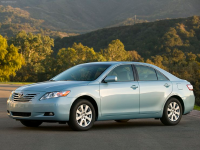
On the early models, the front bumper was bursting under the lower air intake grill. It was usually reinforced by lining from the inner side. True, after the restyling this sore was cured. Headlight washer nozzles often jam in the open position , and in xenon optics bulbs and light units burn out by 100,000 km (from 26,500 "wooden"). Sometimes the instrument panel glitches. The fabric upholstery gets quickly frayed and shiny. The leather is not very durable either.
ONLY TWO ENGINES, BUT WHAT ENGINES!
As for the engines, the dealer Toyota Camry is equipped with gasoline engines: a 2.4 liter "four" (167 hp) and a 3.5 liter V6 (277 hp). Both engines are equipped with a chain in the camshaft drive with the proprietary VVT-i variable valve timing system. The valves of power units are adjusted by selecting washers, but this operation is actually required after 120,000 km. Among the periodically recurring failures is the alternator pulley, turning by 100,000 km of run. At the same time, the alternator itself serves one and a half times longer, and the pulley is replaced separately. Both engines prefer synthetic oil. A surrogate will cause early failure of the hydraulic clutch of the VVT-i system, which costs from . It is recommended to wash the throttle block every 40,000 km , on average, so as not to change the unit prematurely . Bad fuel kills oxygen sensors and mass airflow.
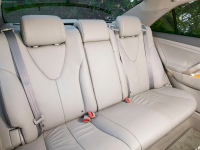
The radiators of the engine and the air conditioner shall be cleaned every two years. Otherwise the cylinder head will "hang" from overheating. By 100 000 km the drive belt tensioner wears out. And the near end of a water pump is indicated by the traces of the brine under the hood and the increased noise of the pump.
On V6, by 150 000 km, the individual ignition coils start to "burn" one by one. But the main trouble is oil leakage due to a leaky oil cooler tube. Since 2009, the oil line became all-metal, and the problem disappeared. The company even held a recall campaign for this malfunction.
THE COST OF THE TRANSMISSION DEPENDS ON THE DRIVING STYLE
The 2.4-liter engine on the Toyota Camry was paired with a 5-speed manual and automatic transmission. The V6 was paired with a six-speed automatic. The manual is irreproachable in terms of reliability. True, it is very rare to find it under the hood of a used sedan. To 40 000-60 000 km transmissions can be switched with appreciable effort because of premature deterioration of clutch release bearing. Detail costs a penny, and for the work will have to lay out about . Around 100,000 km the friction disc of the clutch also becomes worthless.
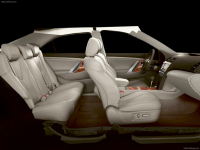
The automatic 5 steps gearbox Aisin U250E is generally durable. If an "automatic" selector will fail, don't panic. Usually it is the fault of faulty end switch, located under a brake pedal. It is worse, when the contact in automatic control unit (which costs fails on run-down copies. Here it is not necessary to search for a new unit - our masters have learned how to repair it.
The Aisin U660E six-speed automatic is also reliable. But its service life directly depends on the driving style. The friction clutches of aggressive driver already wear out by 100,000 km, and as a consequence, the hydraulic block "automatic" channels get clogged with wear products. Therefore, it is desirable to change transmission oil in a gearbox more often - not rarer than in 90 000 km. External CV joints, which are assembled with a half-axle, can become defective by this time.
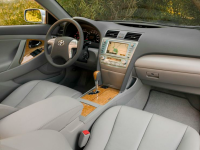
THE RUNNING GEAR IS EXEMPLARY IN TERMS OF RELIABILITY
The Camry's all-independent suspension is durable. The first to wear out are penny bushings of stabilizers, which can often withstand up to 80,000 km. And the rest of the elements are long-livers: the front levers are replaced closer to 130 000 km, and the ball joints and shock absorbers used up to 200 000 km. The rear transverse arms and shock absorbers can also last 200,000 km. The total rebuild of rear suspension costs 1,000 USD.
The steering linkages can withstand an average of 130,000 km. And the rack will easily survive even 200,000 km. But the driveshaft cross will wear out sooner, and the power steering pump high-pressure hose and oil seals can also leak.
The front disks in braking system often become crusty from overheat and by 100,000 km the callipers get jammed, and it is recommended to lubricate them at every service.
In general, a used Toyota Camry is an excellent option for purchase. And it is advisable to stop at a proven option, with a transparent pedigree and without pitfalls. We recommend buying a car after the restyling, not younger than 2009, when most of the childhood diseases of this model were cured.
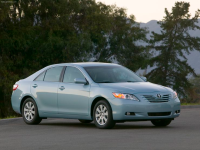

-rear-and-front-view-camera-6.png)

